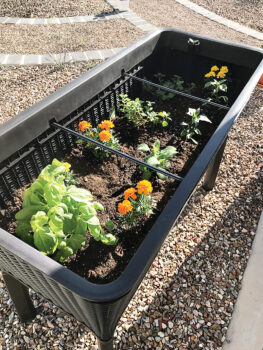Sheilah Britton, Master Gardener, Pinal County
April showers are an unlikely event in the coming month. The average April rainfall in Tucson is .17 inches and that won’t do much to help your garden grow. But there are many things you can do for your garden in this month of near perfect weather that will keep your landscape fairly simple to maintain once the days begin to heat up.
You might begin with what you started in March—pruning any frost damaged trees and shrubs down to live wood so your plants can devote all of their energy to thriving. With average temperatures between the mid-40s for the low and mid-70s for the high, plants will welcome the 13 hours of daylight that will add to their development and overall growth. Cut back cool season annuals and weeds to minimize fire danger.
Finish planting in early April with warm weather annuals such as sunflowers, gaillardia, and coreopsis, as well as transplants of aster, coneflower, yentas, verbena, and vinca. Freshen your summer containers with amended soil and heat tolerant annuals and perennials, including bougainvillea and lantana to brighten up your garden.
In our region, April is a great month for planting vegetables and herbs. For vegetables, consider asparagus, eggplant, beans, melons, chiles, carrots, cucumbers, jicama, summer squash, pumpkin, corn, and watermelons. I had a great surplus of herbs last year including basil, oregano, mint, thyme, and tarragon in a raised bed. Lavender, sage, and rosemary grew well in pots. Mulch both vegetables and herbs with three- to four-inches of organic material before the heat of summer. Mulching helps control weeds, conserve moisture, and regulate the temperature of the soil.
This month is the perfect time to check and reset your irrigation. Make sure all of your drips are working and that you have added more emitters to the canopy of shrubs or trees that have grown during the past year. You want to be able to regulate applications of water so that the soil is moist in the root zone of the plant. As plants grow, the watering period should increase for deeper penetration. In some cases, you might be able to use a trowel or stick to determine the moisture depth. For pots and containers, a moisture meter can be used. As the temperatures rise, you will need to adjust both the frequency and duration of your irrigation. Last summer brought little moisture to our high desert and we were reminded that we sometimes need to supplement water when the monsoon eludes us. Even succulents and cacti have a threshold for how much heat and lack of moisture they can tolerate.
Before you work through these basics, clean all of your garden equipment and tools. Plan your garden with sunlight and shade in mind and consider the microclimates in your landscape. April 30 is Arbor Day so think of planting a new tree in your landscape in celebration. By this time next month, you should be able to literally see the fruits and flowers of your labor.
SaddleBrooke/SaddleBrooke Ranch Master Gardeners are volunteers trained under the auspices of the University of Arizona, Cooperative Extension, Pinal County.
We offer educational programs and classes to residents of our communities.
Please visit our new website at www.extension.arizona.edu/saddlebrooke-master-gardeners.

